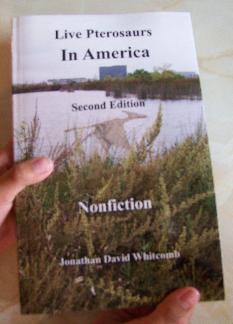Fossils of Rhamphorhynchoid pterosaurs in Cuba is not news; but in the twentieth century, corroborating eyewitnesses, with sightings about six years apart, in the same area of Cuba, observing the same apparent species of long-tailed pterosaur—that is news.
A few days ago, I had a long phone conversation with a registered nurse who lives in California. She feared for her life one day when she was a child at the Guantanamo Bay Naval Base in Cuba. The creature had small teeth but many of them, and when it stood up, it was about as tall as a man. The long tail with a diamond at the end—that made the featherless winged creature very unlike any bat; the teeth made it very unlike any bird in Cuba, indeed very like any bird anywhere.
When the child tried to tell her family about the “flying dinosaur,” they disbelieved her; after all, she was only a child. But six years later, in 1971, the U. S. Marine Eskin Kuhn was stationed at that same base at Guantanamo Bay, and he saw, in clear daylight, two “pterodactyls,” at close range, flying together, and Kuhn was no child. He immediately sketched what he remembered—he was a talented artist—making public his encounter. I interviewed him by phone, last year, and found him to be highly credible. I have no doubt that he saw the same kind of creature seen by Patty Carson, perhaps one of them being the same identical creature as the one the child had seen.
I think it timely to refer to several resources on modern living pterosaurs.
From 1994 through 2009, about nine Americans have intermittently (and usually two or three at a time) visited remote islands of Papua New Guinea, searching for flying creatures: a living pterosaur. On Umboi Island, it’s called “ropen,” but it’s also known as “duwas,” and “seklo-bali.” Most of the evidence they have gathered is native eyewitness testimony.
Extinction of Pterosaurs (or non-extinction) A Reply to Glen Kuban
A flight instructor, with over 13,000 hours of airplane-flying experience, had seen, in 1944, a giant “pterodactyl” with a tail that was at least 10-15 feet long. Duane Hodgkinson lives in Montana.
Pterosaur and Ropen
Is this flying creature, seen and sketched by the U.S. Marine Eskin C. Kuhn, a ropen, like those seen in Papua New Guinea? The two that Mr. Kuhn saw were flying in daylight, in Cuba, in 1971.
In South Carolina, Susan Wooten’s sighting of a giant pterosaur was shocking. It was between Columbia and Florence, in about 1989, on a remote highway surrounded by some swamps and wooded areas.
Giant Bat or Living Pterosaur?
Jonathan Whitcomb, a U.S. forensic videographer who interviewed native islanders in 2004, reported that the “ropen” of Umboi Island is at least similar to a long-tailed pterosaur.
Many other characteristics distinguish the ropen from bats. The giant creatures that appear like Rhamphorhynchoids do not seem to hold themselves upside-down; some natives on Umboi Island described a ropen holding itself upright on a tree trunk. And ropens glow brightly at night with what at least some investigators believe is intrinsic bioluminescence.
This eyewitness of the “Gitmo Pterosaur,” Patty Carson, made it clear in her interview with Whitcomb that she did not see the head crest at first, for the creature’s head was facing her and her brother. But that perspective soon changed as the creature prepared to fly away, and Carson was then able to see the head crest. In addition, she verified that the sketch drawn by Kuhn was very similar to what she had seen, so we can take it as the same type of flying creature, seen in the same area of Cuba, a few years apart.
______________________________________________________________________________________________
 Live “pterodactyls?” In the United States? Many scientists have long assumed all pterosaurs died millions of years ago. Now take a whirlwind tour of many years of investigations in cryptozoology, and prepare for a shock: At least two pterosaur species have survived, uncommon, not so much rare as widely and thinly distributed.
Live “pterodactyls?” In the United States? Many scientists have long assumed all pterosaurs died millions of years ago. Now take a whirlwind tour of many years of investigations in cryptozoology, and prepare for a shock: At least two pterosaur species have survived, uncommon, not so much rare as widely and thinly distributed.
Read the details of these amazing sighting in many states of the U.S.: California, New Mexico, Texas, Arkansas, Florida, South Carolina, Georgia, Ohio, New York, Pennsylvania, Kansas, and many other states: Read the second edition of Live Pterosaurs in America.
Nocturnal pterosaurs have always lived among us, but hidden by something. Enter now the realm of a new branch of cryptozoology, a branch overshadowed by the dogma of a “universal extinction.” How did scientists miss living pterosaurs? Get the answers here, hidden secrets about how these amazing flying creatures of the night have gone mostly unreported: Until recently, almost nobody would listen to eyewitnesses; but for the past seven years many of them have been interviewed by the author of this book.
This book of true eyewitness encounters includes details about the Guantanamo Bay, Cuba, sighting by Eskin Kuhn in 1971.



…and the work goes on. BSM Research Associates is currently correlating the Sonora Desert, Mexico, Texas and Great Lakes videos. Image processing of body and tail flange regions are of primary interest at BSM Research. Once the debunked evolutionary model is removed from real science, then the presence of these so-called extinct animals in the world today becomes tenable. The same argument is applied to plesiosaur and elasmosaur.
Thank you, Cliff
I hope to talk with you soon; we’ve been out of touch too long.